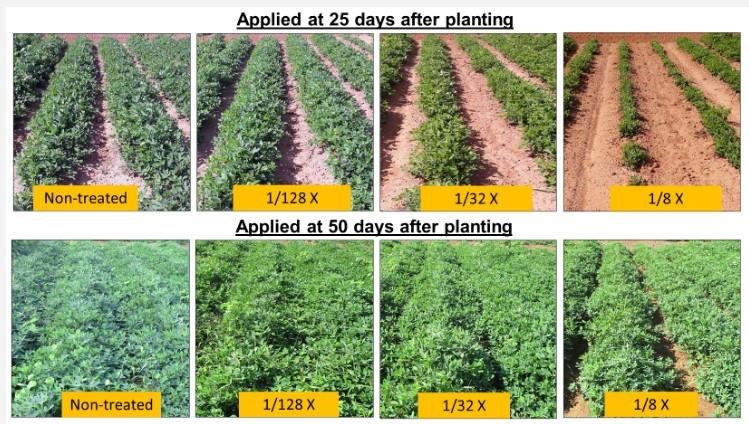Peanut exposed to XtendiMax plus Roundup PowerMax at 25 days after planting (i.e., at vegetative growth stage) showed greater injury compared to exposure at 50 or 75 days after planting (i.e., at pegging and pod development stages). Similar response was observed for peanut yield, where yield loss was greater when peanut was exposed to XtendiMax plus Roundup PowerMax at an earlier stage than the later growth stages. These results suggests that XtendiMax plus Roundup PowerMax drift occurrences on peanut early in the growing season (i.e., vegetative growth stage) could be more severe than drift that occurrs later in the growing seaon (i.e., pod formation and development stages).

Figure 1. Peanut injury at 4 weeks after dicamba plus glyphosate exposure at 25 days after planting (top row) and 50 days after planting (bottom row). Credit: Pratap Devkota, UF/IFAS West Florida Research and Education Center Jay, FL.
Peanut injury response is highly dependent on the exposure amount of XtendiMax plus Roundup PowerMax herbicide. Tank-mixes of XtendiMax plus Roundup PowerMax at less than 1/128 times the labeled rate caused minimal peanut injury and yield loss. However, exposure to the rate above 1/32 times caused significant peanut injury and yield loss. Likewise, the higher injury after exposure also translated into higher yield loss at the end of the season.
This research suggests that in the event of XtendiMax plus Roundup PowerMax drift (or similar dicamba plus glyphosate products), assessment of peanut injury within 1 to 2 weeks afterwards is critical. This timely assessment can be informative for predicting later season crop growth response. Likewise, accounting for the timing of the drift (particularly if it occurs early in the growing season) could be useful in estimating potential yield losses.
Source : ufl.edu